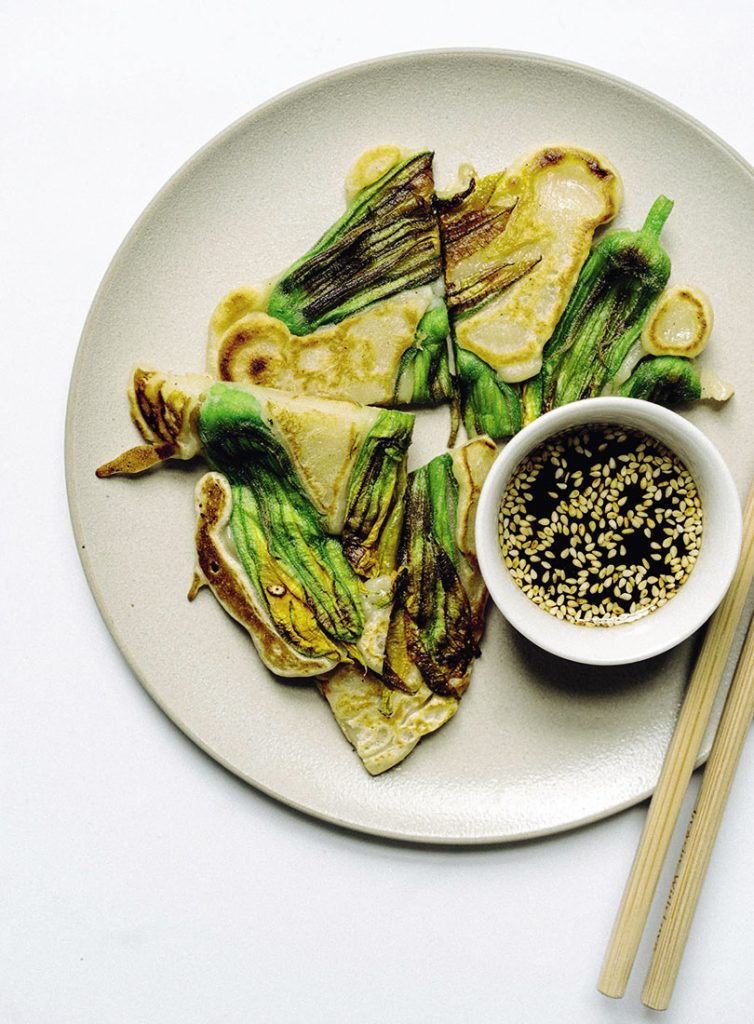Zucchini Flower Pajeon
Hetty Lui McKinnon

Makes
4 x 12cm or 2 x 20cm pancakesIngredients
| 150g (1 cup) plain or gluten-free plain flour | |
| 2 tablespoons potato starch or rice flour | |
| 1 teaspoon sea salt | |
| ½ teaspoon garlic powder or 1 clove garlic, grated | |
| 2 teaspoons doenjang or white (shiro) miso | |
| 250ml (1 cup) ice-cold water | |
| 12–16 zucchini flowers, stamen/pistils and stems removed | |
| neutral oil | |
| DIPPING SAUCE | |
| 2 tablespoons soy sauce or tamari | |
| 1 tablespoon rice vinegar | |
| 1 tablespoon maple syrup | |
| 2 teaspoons roasted sesame oil | |
| 1 teaspoon toasted white sesame seeds |
Pajeon are savoury Korean pancakes. This recipe is based upon one shared with me by New York-based artist and author Erin Jang in my book Family. The wonder of pajeon is that they are endlessly adaptable – when Erin first made them for me, hers comprised artfully arranged carrot, capsicum and zucchini, the vegetables swathed in a light, fragrant batter. Sharing this meal with Erin and her family was a special moment for me and, to this day, I always think of them when I devour these light, crispy pancakes. I love the celestial beauty of zucchini flowers in pajeon – while mellow in flavour, they provide a lovely silkiness. If you don’t have the flowers, I also use finely sliced discs of zucchini (but basically any vegetables that are fast to cook will work). There are generally two ways of making pajeon – you can add the vegetables to the pan first, lightly pan-frying before spooning the batter over, or you can mix the vegetables straight into the batter before frying (like I have instructed below). The latter is the slightly easier option, so it really depends on how you want your finished pajeon to look.
Instructions
| 1. | To make the dipping sauce, whisk together all the ingredients in a small bowl. Set aside. |
| 2. | In a separate small bowl, whisk together the flour, potato starch or rice flour and sea salt. |
| 3. | In another bowl, whisk together the garlic powder or garlic, doenjang or miso and cold water. |
| 4. | Combine the wet and dry ingredients and whisk until smooth and lump-free. |
| 5. | The mixture should be thick, but just pourable. If it looks too thick or stiff, add another 1–2 tablespoons of cold water. |
| 6. | Add the zucchini flowers to the batter and gently fold them through. Don’t overmix – the flowers don’t need to be completely coated in the batter. |
| 7. | Heat a frying pan over medium–high heat and add 1 tablespoon of oil. |
| 8. | Add one-quarter of the batter for small pancakes or half of the batter for larger pancakes. |
| 9. | Cook for 2 minutes, until golden underneath, then flip over. |
| 10. | Cover with a lid, reduce the heat to medium and cook for 2 minutes. |
| 11. | Uncover and cook for an additional 1–2 minutes, using a spatula to press the pancake into the pan, until golden and crispy. |
| 12. | Repeat with the remaining batter (make sure you increase the heat to medium–high before cooking more pancakes). |
| 13. | Slice into squares or wedges and serve immediately, with the dipping sauce on the side. |
 This is an edited extract
This is an edited extract
from Tenderheart
by Hetty Lui McKinnon,
Macmillan Publishers,
RRP $69.99. Food
photography by Hetty
Lui McKinnon, author
photo by Shirley Cai.
